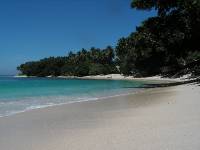Profile
Blog
Photos
Videos
I'd like to point out that the photo here isn't actually that much like where we are. Imagine the same beach, with several thousand people, and around 3 surf boards for every person propped up at the back of the beach under the shade of palm trees with coconuts hanging off them. The length, too, is deceptive. On Kuta for example, where we were earlier, you can see along the beach for miles. The sand is golden and soft and the beach is wide. It truly is perfect for surfing, which is why it's so busy - the one down side.
We've now been all over what I would describe as the South and centre of the island. After originally staying in Kuta when we got here, we set off down to Ulu Watu chasing promises of the best surfing on the island, only to find what was essentially a barbaric and masochistic affair. At Ulu Watu, you arrive at the waves by clambering down rocks, and through what must have been a cave at one point in the not too distant past. You paddle out, trying to time it correctly between the swell of 10ft waves so as not to get picked up by one and thrown into the jagged cliffs' edge. Once you're out there, if you don't catch the wave you'd better say your prayers. A wall of water comes crashing down on you and drags you deep underneath. Beath when you can, for you often surface just in time for the next wave to hit you head on. How is this fun? Anyway, as amateurs, and being as by this time I had never surfed, we were advised not to give it a try. Wise. "A guy died" we were told. It was also by far the most expensive place to rent boards. I wonder why. I bet half don't come back!
After Ulu Watu, we headed north to Sanur. Sanur is your standard beach resort town, Bali style. That is, trees in the middle of the road, children riding mopeds, and every local selling you clothes, a massage, or both (which incidentally is Kuta too, but in Kuta the following are also ubiquitous: surfing, tatooed europeans, weed, mushrooms and transport). We then went inland to Ubud, where we met "the best bar tender in ubud" in a local restaurant called Cinto's. This title was of course self proclaimed, and belonged to a guy called "Bedu". Facebook friend! He did make some good Mojitos, which we drained during a 2 for 1 happy hour on saturday. The drinks were a welcome break when we finally got back after a thorough soaking from a storm after a day's trip to the Volcanoes. The Volcanoes are pretty amazing, large, ominous and surreal, and run like a pointed spine along the back of Bali. Pictures are worth a thousand words, and I will upload some the second I can.
There's a saying that Ubud is "The real Bali", and from what I can see this is not wrong. On your way there you pass some pictoresque rice fields carved out of the hills by generations of Balinese farmers. They are amazing, and run all year round. As a Brit I always thought the UK was green - try coming to Indonesia. The daily thunderstorm throws down torrential rain, with little remit from a thorough soaking for around half an hour unless you're lucky enough to stumble across a shop with a corrugated iron roof you can shelter under for a few minutes. It is intense. The rain falls so quickly and so powerfully it hurts as it pings off your skin. This all makes for a vivid and lush landscape, full of palm trees, frangipani, rice fields, and a plethora of other local flora.
After Ubud we hit up Balian Beach, based on the solid advice from a Balinese surfer dude from Ulu Watu. "You beginner? Go Balian, yeh Balian, it much easier". Whilst it was easier, it was like trying to start surfing like skiing on your first lesson on a red slope instead of the black slope and off piste at Ulu Watu. Stu took a battering, then chundered on the beach, unable to open the bottle of water he desperately needed. Me however, nearly managed to stand on the rough waves, but ended up kneeling then falling off. The power was just too intense! Kuta is much easier for the beginner, trust me! One interesting thing about Balian Beach, which was desolate by comparison to Kuta, was that the sand is volcanic, and therefore black, which is quite strange, and colours the water deeply and darkly.
- comments




